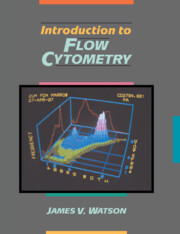Book contents
- Frontmatter
- Contents
- Acknowledgements
- 1 Introduction
- 2 Fluid flow dynamics
- 3 Light and optics
- 4 Electronics
- 5 Computing
- 6 Cell sorting
- 7 Preparation and staining
- 8 Miscellaneous techniques
- 9 Instrument performance
- 10 Light scatter applications
- 11 Nucleic acid analysis
- 12 Nucleic acids and protein
- 13 Chromosomes
- 14 Dynamic cellular events
- 15 Applications in oncology
- 16 Epilogue
- References
- Index
14 - Dynamic cellular events
Published online by Cambridge University Press: 27 October 2009
- Frontmatter
- Contents
- Acknowledgements
- 1 Introduction
- 2 Fluid flow dynamics
- 3 Light and optics
- 4 Electronics
- 5 Computing
- 6 Cell sorting
- 7 Preparation and staining
- 8 Miscellaneous techniques
- 9 Instrument performance
- 10 Light scatter applications
- 11 Nucleic acid analysis
- 12 Nucleic acids and protein
- 13 Chromosomes
- 14 Dynamic cellular events
- 15 Applications in oncology
- 16 Epilogue
- References
- Index
Summary
Time-dependent biological events monitored by flow cytometry have been studied almost since the technology was invented and examples of DNA histogram changes in populations of cells released from a synchronizing event giving cell cycle kinetic data were described in section 11.5.3. In these types of study the time-dependent biological reference frame is long and sampling the population at intervals of hours gives the required resolution and information. In this chapter the use of flow technology to study dynamic events within the temporal reference frame of a few seconds to minutes will be considered. The majority of such studies have been conducted in the general area of enzyme reaction kinetics, termed flow cytoenzymology (FCE) (Dolbeare and Smith, 1979; Watson, 1980a,b; Dolbeare, 1981; Watson, 1984), where the aim is to determine both the quantities and activities of enzymes in populations of single intact cells. However, similar techniques can also be used to determine rates of influx or efflux of molecules across the cell membrane, binding of ligands to intracellular constituents, and changes in intracellular calcium, pH and membrane potential in response to various stimuli.
Total quantities of enzymes can be determined using antibodies (Coons et al., 1941) or fluorescently labelled tight-binding inhibitors (Gapski et al., 1975) and activities can be determined using various fluorogenic and non-fluorogenic substrates which yield fluorescent and light-absorbing products respectively. With increasing time after mixing cells with substrate greater quantities of either fluorescent or light-absorbing product are released within or on the cells of the population, and these can be monitored quantitatively with time.
Information
- Type
- Chapter
- Information
- Introduction to Flow Cytometry , pp. 309 - 344Publisher: Cambridge University PressPrint publication year: 1991
